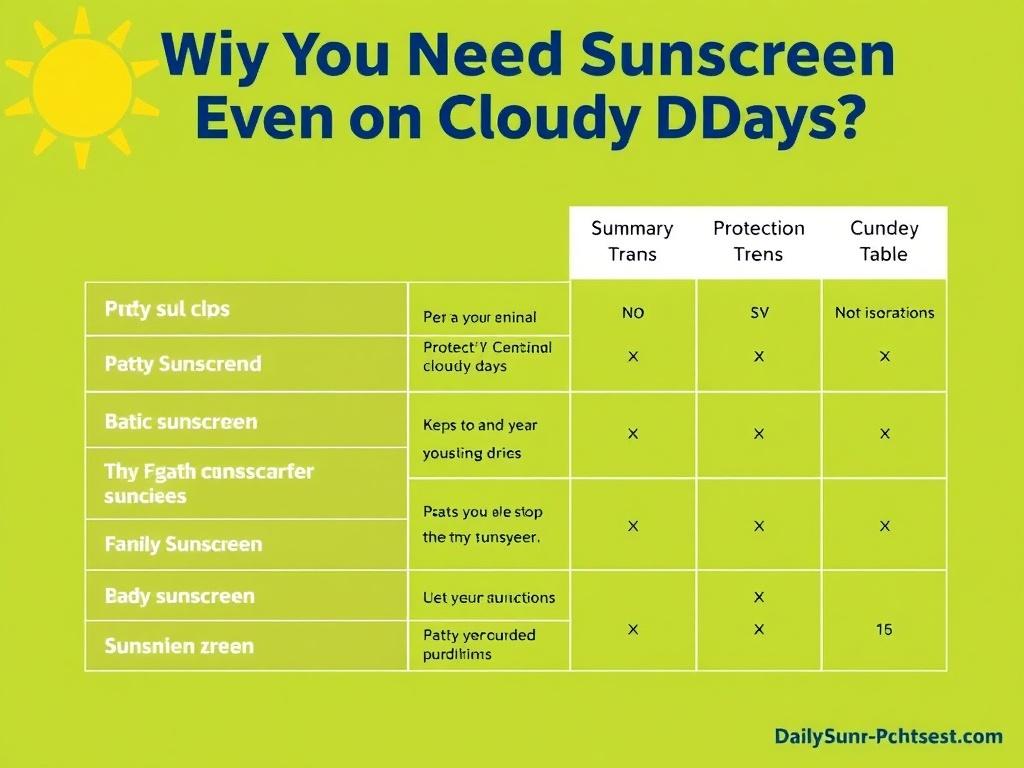Содержание статьи
When most people think about sunscreen, they instantly imagine bright sunny days at the beach or a picnic under the blazing summer sun. But have you ever paused to wonder whether you really need to apply sunscreen when the sky is overcast or the weather feels cool? The answer may surprise you—yes, you absolutely need sunscreen even on cloudy days. This topic is important because many underestimate the hidden dangers of UV radiation that can penetrate clouds and still affect your skin. Protecting your skin isn’t just about avoiding sunburn; it’s about safeguarding your long-term skin health.
Sunscreen is often viewed as a summer-only product, yet dermatologists recommend using it daily regardless of weather conditions. Understanding why this is essential involves diving into how the sun’s rays work and how UV radiation can pass through clouds. It’s not just about heat or sunshine—it’s about invisible rays that can cause skin damage, premature aging, and increase your risk of skin cancer. When you wear sunscreen every day, even on gloomy or rainy days, you’re consistently blocking these harmful rays and taking a crucial step toward healthier skin.
Understanding UV Radiation and Its Effects
To grasp why sunscreen is necessary all year round and during cloudy weather, you first need to understand what UV radiation is and how it affects your skin. The sun emits different types of rays, but the two that concern us the most are UVA and UVB rays. Both types contribute to skin damage, but in different ways.
UVA rays account for about 95% of the UV radiation reaching the Earth’s surface. These rays penetrate deep into the skin layers, causing long-term damage. UVA exposure is linked to premature skin aging, wrinkles, and contributes to the development of skin cancer. What’s crucial is that UVA rays can pass through clouds and glass, meaning indoor exposure isn’t negligible either.
UVB rays are the primary cause of sunburn and play a significant role in the development of skin cancer. Unlike UVA, UVB rays don’t penetrate as deeply but are more intense during sunny days, especially between 10 a.m. and 4 p.m. While clouds can block some UVB rays, they do not block UVA rays effectively. This means your skin is still vulnerable on cloudy days.
How Clouds Affect UV Exposure
One of the biggest misconceptions about sun protection is that clouds block UV rays. The truth, however, is quite different. Clouds can reduce UV radiation to some degree, but many types of clouds only partially block these rays. Thin or scattered clouds may even enhance UV exposure due to a phenomenon called “cloud edge effect,” where UV rays scatter and reflect around cloud edges, increasing exposure unexpectedly.
Table: Effects of Different Weather Conditions on UV Radiation
| Weather Condition | UV Radiation Penetration | Risk of Skin Damage |
|---|---|---|
| Clear Sunny Day | High | High risk (especially UVB rays) |
| Partly Cloudy Day | Moderate to High (cloud edge effect) | Moderate to High risk |
| Overcast Day | Moderate (up to 80% UV rays penetrate) | Moderate risk |
| Heavy Cloud Cover/Rain | Reduced but still present | Low to Moderate risk |
This table helps illustrate that UV rays are rarely fully blocked by clouds, which means your skin remains at risk even if you don’t feel the warmth of the sun.
The Hidden Dangers: Why You Need Sunscreen Even on Cloudy Days
You might ask, “If it’s cloudy, why do I need sunscreen?” This question is more common than you think. The short answer is that harmful UV rays are invisible but consistently damaging. Here are the key reasons why sunscreen is essential on cloudy days.
1. UV Rays Can Cause Skin Cancer
Skin cancer is the most common type of cancer worldwide, and UV exposure is its leading cause. Both UVA and UVB rays damage skin cells’ DNA, leading to mutations that may develop into cancer. Wearing sunscreen daily, including on cloudy days, helps reduce cumulative UV exposure and lowers your skin cancer risk over time.
2. Prevention of Premature Aging
Have you noticed fine lines, wrinkles, and age spots even when you didn’t spend much time under direct sun? UVA rays are responsible for photoaging, which breaks down collagen and elastin in the skin. Since these rays penetrate clouds, you can experience skin aging even when it’s gloomy outside.
3. Protection from Sunburns Even on Overcast Days
Sunburns don’t have to happen only on sunny days. UVB rays, although reduced by clouds, can still cause burning. Sunburn is an immediate sign of skin damage and increases your risk of melanoma later in life.
4. Not All Clouds Are Equal
The type and density of cloud cover play a role in UV exposure. Thin clouds may do little to reduce UV radiation. As we saw with the table above, up to 80% of UV rays can penetrate on an overcast day, which makes sunscreen indispensable.
How to Choose the Right Sunscreen for Any Weather

Now that you understand why using sunscreen daily is so important, how do you choose the right product? Sunscreen needs to be both effective against UVA and UVB rays and suitable for your skin type and lifestyle.
Understanding SPF and Broad Spectrum Protection
SPF, or Sun Protection Factor, measures how well a sunscreen protects you from UVB rays. For daily use, dermatologists generally recommend an SPF of 30 or higher. However, SPF doesn’t indicate UVA protection, which is why you should look for “broad spectrum” on the label. Broad spectrum sunscreens protect against both UVA and UVB rays.
Types of Sunscreens
Sunscreens fall into two categories: chemical and physical. Chemical sunscreens absorb UV radiation, while physical sunscreens (sometimes called mineral sunscreens) reflect and scatter UV rays.
- Chemical Sunscreens: Ingredients like avobenzone, oxybenzone, or octinoxate absorb UV rays. They tend to be lightweight and less visible on skin but can sometimes irritate sensitive skin.
- Physical Sunscreens: Ingredients such as zinc oxide or titanium dioxide sit on the skin surface and deflect rays. These are often recommended for sensitive skin and provide immediate protection after application.
Water Resistance and Other Features
If you’ll be active outdoors or sweating, consider water-resistant formulas. Also, many sunscreens include moisturizing agents, antioxidants, or tinted formulations to protect and nourish the skin further. Choose a sunscreen that suits your daily activities and skin needs.
Applying Sunscreen Correctly on Cloudy Days

Many people apply too little sunscreen or forget to reapply, which reduces its effectiveness. Follow these tips to make sunscreen work best for you, rain or shine.
How Much Sunscreen to Use
A general guideline is to use about one ounce (roughly a shot glass full) to cover your entire body. For the face alone, a nickel-sized amount is a good start. Apply generously and evenly to all exposed skin.
When to Apply
Apply sunscreen 15 to 30 minutes before sun exposure to allow it to bind properly to your skin. Even on cloudy days, don’t wait until you step outside—make it a part of your morning routine.
Reapplication Is Key
Sunscreen wears off due to sweating, swimming, or simply over time. Reapply every two hours, or immediately after swimming or heavy sweating. On cloudy days, people often skip reapplying, but this is a mistake.
Checklist for Effective Sunscreen Use
- Apply every morning, rain or shine
- Use broad-spectrum, SPF 30 or higher
- Don’t forget easy-to-miss spots like ears, neck, and hands
- Reapply every 2 hours if outdoors
- Combine with protective clothing and sunglasses
Additional Ways to Protect Your Skin on Cloudy Days
While sunscreen is your frontline defense, combining it with other protective measures enhances your skin’s safety.
Wear Protective Clothing
Long-sleeved shirts, wide-brimmed hats, and UV-blocking sunglasses shield your skin and eyes from UV damage. Fabrics with UPF (Ultraviolet Protection Factor) ratings offer better protection.
Seek Shade When Possible
Even on cloudy days, staying in the shade reduces direct UV exposure. Trees, umbrellas, or canopies are simple ways to create your own shade.
Be Mindful of Reflective Surfaces
Water, sand, snow, and even pavement reflect UV rays, increasing your exposure. This is particularly important during cloudy days when you might underestimate the risk.
Summary Table: Daily Sun Protection Tips

| Action | Why It Matters | Tip |
|---|---|---|
| Apply broad-spectrum SPF 30+ sunscreen daily | Protects against UVA and UVB rays, even on cloudy days | Include sunscreen as a morning skincare step |
| Reapply every two hours | Maintains protection after sweating or washing off | Keep sunscreen handy during outdoor activities |
| Wear protective clothing | Provides physical barrier from UV rays | Choose UPF-rated garments for extra safety |
| Use sunglasses and hats | Protects eyes and face from UV damage | Wide-brim hats offer best coverage |
| Seek shade when outdoors | Reduces direct UV exposure and risk | Especially valuable during peak sun hours |
Conclusion
Sunscreen is a vital part of everyday skin protection, not just a seasonal or sunny-day product. Even on cloudy or overcast days, harmful UVA and UVB rays penetrate through clouds and can cause both immediate and long-term damage to your skin—ranging from sunburns and premature aging to serious conditions like skin cancer. By understanding how UV radiation works and following simple sun safety habits, including applying broad-spectrum sunscreen daily and taking advantage of additional protective measures, you can keep your skin healthy and vibrant year-round. Don’t let a little cloud cover fool you—your skin needs protection every day, regardless of the weather.

